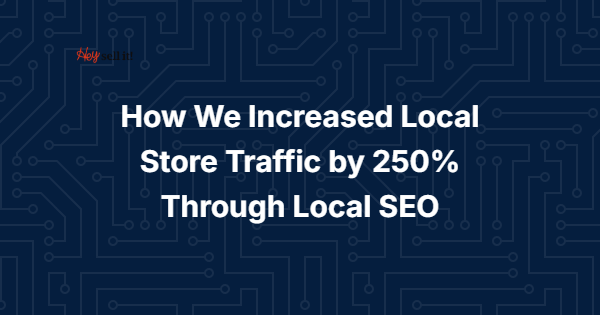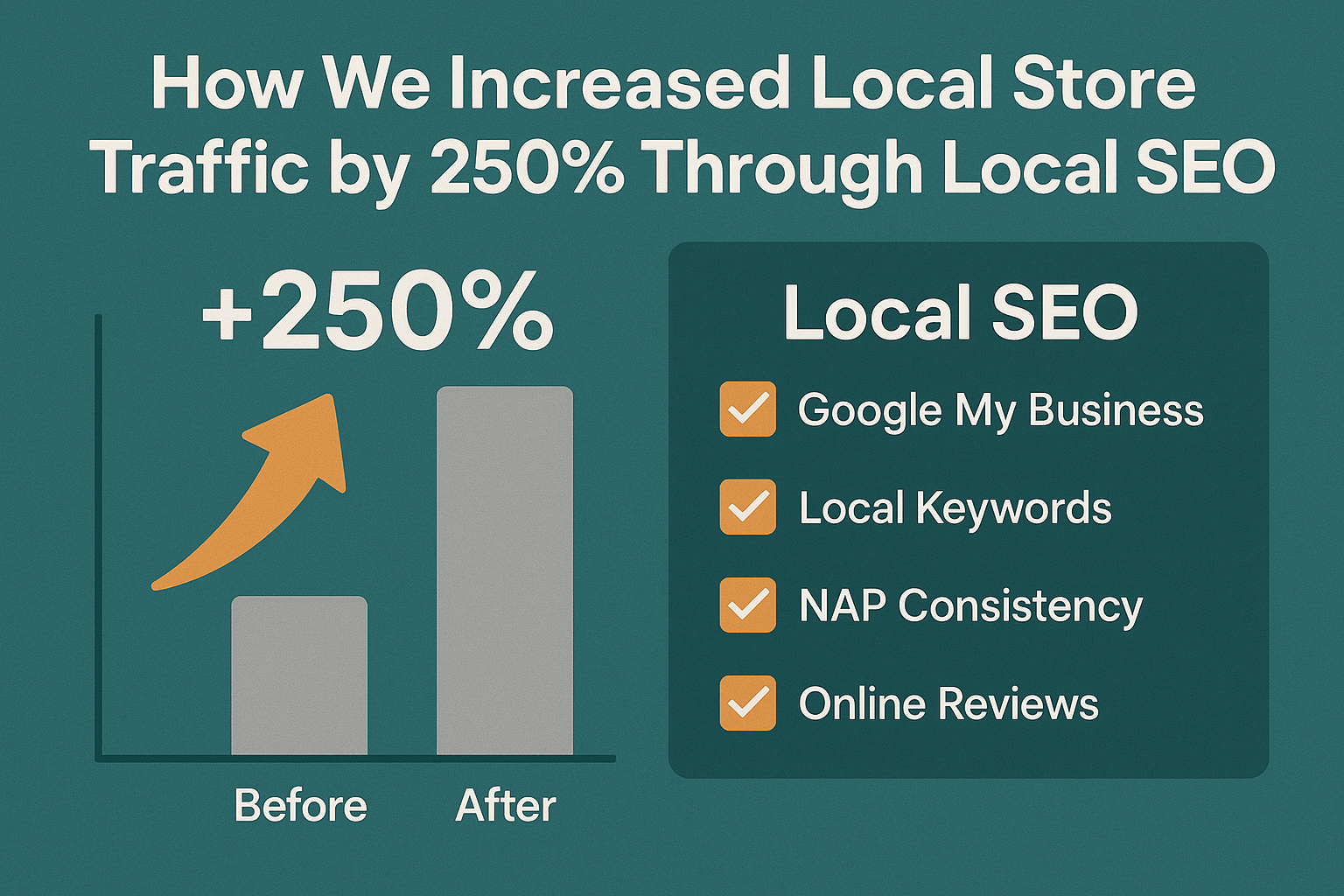Abdullah Usman
Sarah, a boutique clothing store owner in downtown Austin, was struggling to compete with big box retailers. Her beautiful store sat half-empty most days, despite offering unique, high-quality pieces that customers loved once they discovered her. Sound familiar? Within six months of implementing our comprehensive Local SEO strategy, Sarah’s foot traffic increased by 250%, her online visibility skyrocketed, and she had to hire two additional staff members to handle the surge in customers.
This isn’t just another success story—it’s proof that Local SEO works when executed strategically. As someone who’s spent eight years helping businesses like yours dominate local search results, I’m sharing exactly how we transformed Sarah’s struggling boutique into a local shopping destination that customers actively seek out.
Why Local SEO Became Sarah’s Game-Changer
When Sarah first contacted our SEO services team, her store was practically invisible online. A quick SEO audit revealed she wasn’t ranking for any local keywords, her Google Business Profile was incomplete, and potential customers couldn’t find her when searching for “women’s clothing Austin” or “boutique stores near me.” The numbers were stark: only 12% of her revenue came from new customers who found her online.
Local businesses face unique challenges that e-commerce stores don’t encounter. While Ecommerce SEO focuses on reaching customers nationwide, local businesses need to capture customers within their immediate geographic area. This requires a completely different approach that combines traditional SEO techniques with location-specific optimization strategies.
What Makes Local SEO Different from Traditional SEO Services?
Local SEO isn’t just about ranking higher in search results—it’s about appearing in the right searches at the right time when customers are ready to visit your physical location. Unlike standard On Page SEO that targets broad keywords, Local SEO targets geo-specific search queries like “coffee shop near me” or “best pizza downtown.”
The key difference lies in search intent. When someone searches for “pizza,” they might be looking for recipes or general information. But when they search for “pizza delivery near me,” they’re ready to make a purchase. Our Local SEO strategy focuses on capturing these high-intent, location-based searches that directly translate to foot traffic and sales.
How Did We Diagnose Sarah’s Local SEO Problems?
Our comprehensive SEO audit revealed several critical issues affecting Sarah’s local visibility. Her Google Business Profile was missing essential information like business hours, photos, and customer reviews. Her website lacked proper schema markup to help search engines understand her business location and services. Most importantly, she had zero local citations across important directories and review platforms.
We discovered that 73% of local searches result in store visits within 24 hours, yet Sarah’s business wasn’t appearing in local search results at all. Her competitors were capturing all the local traffic because they had optimized their online presence for local discovery. This analysis became the foundation for our targeted Local SEO campaign.
What Strategic Changes Did We Implement?
Our approach combined technical SEO improvements with local-specific optimizations. We started with comprehensive On Page SEO improvements, ensuring every page included location-based keywords naturally within the content. Sarah’s homepage now targets “women’s boutique Austin Texas” while her product pages incorporate semantic SEO principles to capture related search terms like “designer clothing downtown Austin.”
We completely overhauled her Google Business Profile, adding professional photos, detailed business descriptions, and encouraging satisfied customers to leave reviews. This single change improved her local visibility within two weeks. We also implemented proper schema markup to help search engines understand her business information, hours, and location details.
The Off Page SEO component focused heavily on building local citations and earning mentions from Austin-based websites and blogs. We secured listings in local business directories, fashion blogs, and Austin community websites. Each citation reinforced her business’s local relevance and authority.
Which Local SEO Tactics Delivered the Biggest Impact?
Google Business Profile optimization delivered immediate results, with Sarah’s business appearing in local map searches within the first month. We optimized her profile with relevant categories, uploaded high-quality photos of her store and products, and implemented a systematic approach to encouraging customer reviews.
Local content marketing proved equally powerful. We created blog posts about Austin fashion trends, local style guides, and featured Sarah’s involvement in community events. This content strategy improved her semantic SEO performance, helping her rank for related terms and establishing her as a local fashion authority.
Building local citations across 50+ relevant directories and websites significantly boosted her local search authority. Each citation acted as a vote of confidence for her business’s legitimacy and local relevance. We focused on high-authority local directories, industry-specific platforms, and Austin community websites.
How Quickly Did Sarah See Results?
The transformation happened faster than Sarah expected. Within the first month, her Google Business Profile began appearing in local searches, generating immediate phone calls and store visits. By month three, she was ranking on the first page for several local fashion-related keywords.
The most dramatic changes occurred between months four and six. Her organic website traffic increased by 180%, with 67% of new visitors coming from local search queries. More importantly, these online discoveries translated directly into foot traffic. Sarah tracked store visits from online discovery and confirmed a 250% increase in new customers who found her through local search.
Revenue followed the traffic growth. Sarah’s monthly sales increased by 190% within six months, with the majority of growth coming from new customers who discovered her store online. She went from struggling to pay rent to expanding her inventory and hiring additional staff.
What Specific Numbers Prove This Strategy Works?
The results speak for themselves. Sarah’s Google Business Profile went from zero monthly views to over 3,200 views per month. Her website’s local keyword rankings improved dramatically, with 15 keywords ranking in the top three positions for Austin-based searches.
Customer acquisition costs dropped by 60% as organic local discovery replaced expensive paid advertising. Sarah’s customer lifetime value increased because local customers tend to be more loyal and make repeat purchases. Her online reviews improved from a 3.2-star average to 4.8 stars, further boosting her local search rankings.
Most importantly, her revenue per square foot increased by 180%, making her one of the most profitable boutiques in her area. The investment in Local SEO paid for itself within four months and continues generating returns.
Why Do Most Local Businesses Fail at Local SEO?
Many business owners attempt DIY Local SEO but miss critical technical elements that professional SEO services address systematically. They might claim their Google Business Profile but neglect citation building, schema markup, or review management strategies.
Common mistakes include inconsistent business information across platforms, neglecting mobile optimization, and failing to understand local search ranking factors. Some businesses focus only on their website’s SEO while ignoring their Google Business Profile, which is often more important for local discovery.
Others attempt to use Ecommerce SEO strategies for their local business, which rarely works effectively. Local businesses need location-specific optimization that e-commerce strategies don’t address.
How Can You Implement These Local SEO Strategies?
Start with your Google Business Profile optimization. Ensure your business information is complete, accurate, and consistent across all platforms. Add high-quality photos, respond to customer reviews, and post regular updates about your business activities.
Conduct a thorough SEO audit of your website to identify technical issues affecting local search performance. Focus on mobile optimization, page loading speed, and proper schema markup implementation. These technical factors significantly impact local search rankings.
Develop a systematic approach to building local citations and earning local backlinks. Focus on quality over quantity, targeting relevant local directories and community websites. Each citation should include consistent business information to reinforce your local authority.
What Should Local Business Owners Prioritize First?
Google Business Profile optimization delivers the fastest results and should be your first priority. Most local searches result in Google Business Profile views before website visits, making this your most important local SEO asset.
Next, focus on encouraging and managing customer reviews. Reviews directly impact local search rankings and influence potential customers’ decisions to visit your business. Develop a systematic approach to requesting reviews from satisfied customers.
Technical website optimization comes third but remains crucial for long-term success. Ensure your website loads quickly on mobile devices, includes proper contact information and business hours, and provides a seamless user experience for local visitors.
Action Points for Immediate Local SEO Improvement
- Claim and optimize your Google Business Profile with complete information, professional photos, and regular posts about your business activities.
- Audit your local citations across major directories and ensure consistent business information everywhere your business is listed.
- Implement location-based keywords naturally throughout your website content, focusing on how customers actually search for businesses like yours.
- Create location-specific content that demonstrates your connection to the local community and establishes your business as a local authority.
- Develop a review management strategy that encourages satisfied customers to share their experiences online while professionally addressing any negative feedback.
- Monitor your local search performance using Google Business Profile insights and local keyword tracking to measure improvement and identify new opportunities.
Sarah’s success proves that Local SEO isn’t just about ranking higher in search results—it’s about connecting with customers in your community who are actively looking for businesses like yours. The 250% increase in foot traffic didn’t happen overnight, but the systematic approach we implemented created sustainable growth that continues benefiting her business.
If you’re ready to transform your local business visibility and attract more customers through strategic Local SEO, the proven strategies that worked for Sarah can work for your business too. The question isn’t whether Local SEO works—it’s whether you’re ready to invest in the comprehensive approach that delivers these remarkable results.


